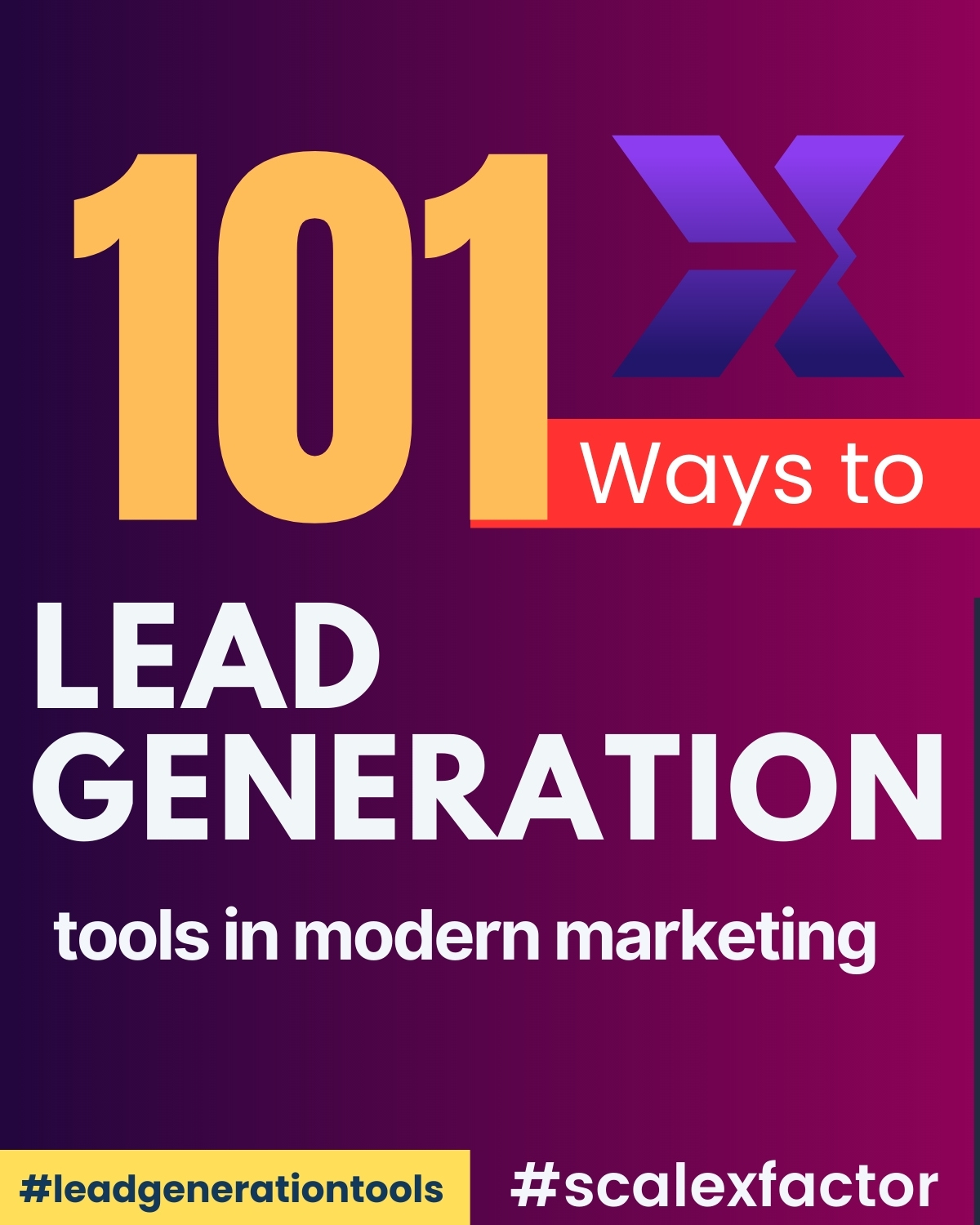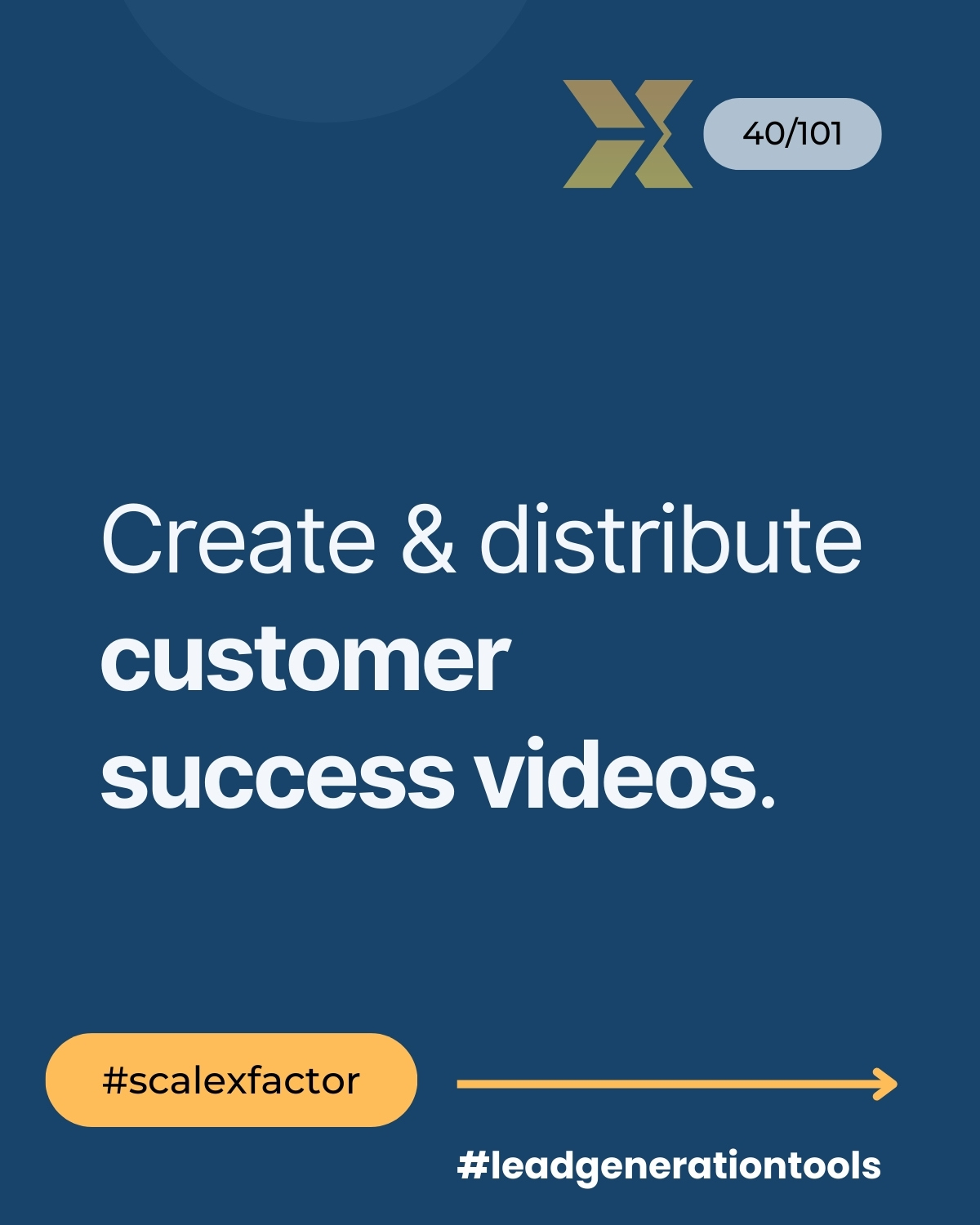Join fifteenth part of our captivating journey through “101 Ways of Lead Generation – Tools in Modern Marketing.” Its 101 ways of Lead Generation with Lead Generation Tools by ScaleXFactor – Part 14 of 33. In this installment, we delve into the realm of creativity and collaboration, exploring three remarkable techniques to expand your reach and engage your audience.

Firstly, we uncover the power of customer success videos. Prepare to be moved as we showcase real stories of triumph and satisfaction, demonstrating how your product or service has positively impacted lives.
Next, we unveil the allure of exclusive gated content. By offering valuable resources accessible only to email subscribers, you will foster a sense of exclusivity and intrigue, compelling your audience to join your growing community.

Lastly, we uncover the magic of partnerships. Discover the potential of collaborating with non-competing businesses for joint promotions, amplifying your brand’s visibility and reaching new audiences together.

Get ready to be inspired, informed, and equipped with the knowledge to revolutionize your lead generation tools and strategies. Dive into this enriching chapter and unlock the secrets to success.
| 40th Lead Generation Tools | Create and distribute customer success videos. |
| 41st Lead Generation Tools | Offer exclusive gated content for email subscribers. |
| 42nd Lead Generation Tools | Develop partnerships with non-competing businesses for joint promotions. |
Create and distribute customer success videos Explanation
Customer success videos are a powerful tool for showcasing satisfied customers and their positive experiences with your product or service. By capturing their testimonials and stories in video format, you can inspire trust, engage your audience, and boost brand credibility. These videos can be shared on various platforms to amplify their impact.

Pros:
- Builds trust and credibility: Customer success videos provide authentic social proof, showcasing real customers who have benefited from your offerings.
- Engages and inspires: Videos have a captivating and emotional impact, making it easier for viewers to connect with your brand and envision their own success.
- Enhances brand storytelling: Videos allow you to craft compelling narratives that resonate with your target audience, creating a lasting impression.
- Increases conversion rates: By showcasing successful outcomes, customer success videos can influence potential customers and drive conversions.
- Broadens reach: Videos can be shared across social media, websites, and email campaigns, allowing you to reach a wider audience.
Cons:
- Production costs: Creating high-quality videos may require investments in equipment, software, and professional editing services.
- Time-consuming process: Planning, filming, and editing customer success videos can be time-intensive, requiring coordination with customers and editing teams.
- Dependence on customer participation: The success of these videos relies on customers being willing to participate and share their experiences.
- Limited control over customer feedback: While customer success videos aim to highlight positive experiences, there is a risk of negative feedback surfacing during the process.
- Potential viewer skepticism: Some viewers may perceive customer success videos as biased or staged, potentially impacting their trust in the content.
FAQs:
Q1: What is the purpose of customer success videos?
A1: Customer success videos are created to showcase satisfied customers and their positive experiences, inspiring trust and credibility in your brand.
Q2: How can I create compelling customer success videos?
A2: To create impactful videos, focus on authentic storytelling, featuring real customers and their genuine testimonials. Use engaging visuals and concise editing techniques.
Q3: Where can I share customer success videos?
A3: Customer success videos can be shared on your website, social media platforms, YouTube, and incorporated into email marketing campaigns.
Q4: How long should customer success videos be?
A4: It’s best to keep customer success videos concise, typically ranging from 1 to 3 minutes, to maintain viewer engagement.
Q5: Can I use customer success videos for different products or services?
A5: Yes, customer success videos can be tailored to showcase success stories for various offerings within your brand’s portfolio.
Offer exclusive gated content for email subscribers Explanation
Gated content refers to valuable and exclusive resources such as e-books, whitepapers, webinars, or case studies that are accessible only to those who provide their email addresses. This strategy incentivizes visitors to subscribe to your email list, allowing you to build a direct line of communication and nurture leads effectively.

Pros:
- Lead generation: Gated content encourages visitors to share their email addresses, providing you with valuable leads for targeted marketing campaigns.
- Establishes thought leadership: Offering valuable and insightful gated content positions your brand as an authority in your industry, increasing trust and credibility.
- Personalized communication: By capturing email addresses, you can engage with subscribers directly, tailoring your marketing messages to their needs and interests.
- Increases website traffic: Promoting gated content entices visitors to explore your website, boosting overall traffic and engagement metrics.
- Enables data-driven marketing: Email addresses allow you to analyze and segment your audience, delivering more targeted and personalized marketing campaigns.
Cons:
- Limited accessibility: Gated content may discourage some visitors from engaging with your brand if they are not willing to provide their email addresses.
- Content quality expectations: To ensure visitors perceive the gated content as valuable, it must meet or exceed their expectations, requiring additional effort in content creation.
- Maintenance and updates: As gated content evolves, regular updates are necessary to keep it relevant and valuable, which requires ongoing time and resources.
- Potential for unsubscribes: Some subscribers may choose to unsubscribe after receiving the gated content they were interested in, reducing your email list size.
- Trust and privacy concerns: Visitors may be hesitant to share their email addresses due to concerns about spam or the misuse of their personal information.
FAQs:
Q1: What types of gated content can I offer?
A1: You can offer a variety of resources, such as e-books, whitepapers, templates, webinars, case studies, exclusive video content, or access to online communities.
Q2: How do I promote gated content effectively?
A2: Promote your gated content through targeted landing pages, social media campaigns, blog posts, and email marketing to maximize visibility and conversion rates.
Q3: Can I reuse or repurpose existing content as gated content?
A3: Yes, you can repurpose existing valuable content to create gated resources. However, ensure that the content remains exclusive and offers additional value to subscribers.
Q4: Should I gate all my content?
A4: It’s recommended to strike a balance between gated and freely accessible content to cater to different audience segments and maximize engagement.
Q5: How can I measure the effectiveness of gated content?
A5: By tracking metrics such as conversion rates, email open rates, click-through rates, and subscriber engagement, you can assess the impact and effectiveness of gated content.
Develop partnerships with non-competing businesses for joint promotions Explanation
Partnering with non-competing businesses allows you to leverage each other’s customer base, resources, and expertise. By collaborating on joint promotions, you can increase brand exposure, reach new audiences, and generate mutually beneficial results.

Pros:
- Expanded reach and visibility: Joint promotions introduce your brand to a new audience through your partner’s customer base and marketing channels.
- Cost-effective marketing: Sharing marketing expenses with a partner reduces the financial burden and allows for more extensive campaigns.
- Access to new markets: Partnering with a business that targets a different customer segment opens doors to new markets and potential customers.
- Enhanced credibility and trust: Associating with a trusted non-competing brand can boost your brand’s credibility and instill trust in your offerings.
- Synergistic expertise: Partnering with a complementary business provides access to specialized skills, knowledge, or resources that can enhance your marketing efforts.
Cons:
- Misaligned goals and values: If not carefully chosen, a partnership with a non-competing business may result in conflicting objectives or mismatched values.
- Brand dilution: Partnering with a business that has a significantly different brand image or reputation might dilute your brand identity or confuse your target audience.
- Dependency on partner cooperation: Successful joint promotions rely on effective collaboration and coordination with the partner, which can be challenging to achieve.
- Limited control over partner actions: As joint promotions involve shared activities, there is a potential loss of control over the partner’s actions or marketing messages.
- Potential competition in the partnership: Over time, the partnership might evolve, and both businesses may become competitors in the same market, leading to conflicts of interest.
FAQs:
Q1: How can I find suitable non-competing businesses for partnerships?
A1: Look for businesses that target a similar audience but offer complementary products or services. Networking events, industry associations, and online directories can be helpful in finding potential partners.
Q2: How do I ensure a mutually beneficial partnership?
A2: Clearly define goals, expectations, and responsibilities through a partnership agreement or contract. Regular communication and transparency are key to maintaining a successful collaboration.
Q3: What types of joint promotions can be pursued?
A3: Joint promotions can include co-branded campaigns, cross-promotions, bundled offerings, referral programs, or joint events.
Q4: How do joint promotions benefit both businesses?
A4: Joint promotions allow businesses to access new customers, increase brand exposure, share marketing costs, and leverage each other’s expertise and resources.
Q5: How long should a partnership agreement typically last?
A5: Partnership durations vary depending on the goals and nature of the collaboration. Some partnerships may be project-specific, while others may be long-term strategic alliances. Regular evaluations can help determine if the partnership should continue or be modified.
Conclusion: Congratulations on completing this comprehensive guide! We’ve explored three effective marketing strategies: creating customer success videos, offering exclusive gated content, and developing partnerships for joint promotions. Armed with engaging explanations, pros and cons, and answers to frequently asked questions, you’re now equipped to unlock your marketing potential. Remember to adapt these strategies to your specific business needs and continuously evaluate their impact. Embrace innovation, test new ideas, and watch your marketing efforts flourish. Best of luck on your journey to success!




